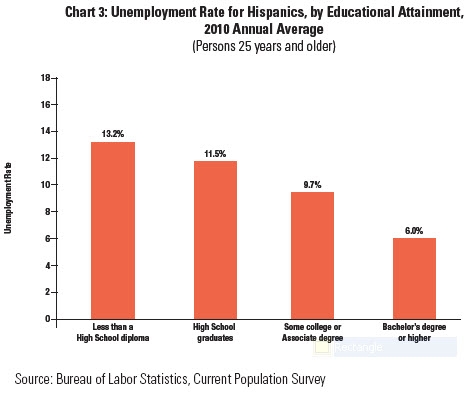At nearly 23 million, people of Hispanic or Latino ethnicity represented 15 percent of the United States' labor force in 2010. By 2018, Hispanics are expected to comprise 18 percent of the labor force.
A report released by the U.S. Department of Labor indicates that in 2010, 59 percent of Hispanics aged 16 and over were employed and just under 1 in 5 of those employed were working part-time. Forty-one percent of all employed Hispanics in 2010 were women, compared to 46 percent among employed whites. Women represent a smaller share of the Hispanic labor force both because of the high labor force participation of Hispanic men and the lower labor force participation rate of Hispanic women compared to whites.

Hispanics are more likely than either whites or blacks to be employed in the private sector, with more than 8 in 10 employed Hispanics working in the private sector, not including the unincorporated self-employed. Conversely, Hispanics are less likely to work for government than are either whites or blacks. Self-employment is a growing alternative to private sector employment among Hispanics. According to the most recent Census Bureau Survey of Business Owners (2007), Hispanic-owned businesses are the fastest growing small business sector, expanding at nearly twice the rate of the national average between 2002 and 2007.
Half of Hispanics working full-time earned $535 or more per week in 2010. This median weekly wage was only 70 percent of that earned by whites.
The unemployment rate averaged 12.5 percent among Hispanics in 2010. The most recent unemployment report in February 2011 shows that the economic situation is improving for all Americans, including Hispanics, who have seen their unemployment rate decline to 11.6 percent. In addition, unemployed Hispanics experience a shorter duration of unemployment and are less likely to join the ranks of the long-term unemployed than are either their white or black counterparts. However, the higher rate of unemployment among all Hispanics means that a greater share of Hispanics will experience long-term unemployment than will whites.

Hispanic youth (ages 16-19) have much higher unemployment rates than do adults. The unemployment rate for Hispanic youth reached a high of 32.2 percent in 2010 and as of February 2011 had fallen to 30.6 percent.
Unemployment rates are lowest among those with a bachelor's degree or higher. For instance, the 2010 unemployment rate among Hispanics with at least a bachelor's degree was 6.0 percent, (compared to 4.3 percent for whites). Unemployment rates are higher for those with fewer years of schooling. In 2010, 11.5 percent of Hispanics in the labor force with only a high school degree were unemployed (compared to 9.5 percent of whites with only a high school degree), and 13.2 percent of Hispanics in the labor force with less than a high school degree (compared to 13.9 percent among whites with less than a high school degree) were unemployed.
Hispanic employment declined most significantly in construction, manufacturing, financial activities, and in professional and business services during the recession of 2007-2009. Together, these industries accounted for nearly 1.1 million jobs lost among Hispanic workers.
Hispanics account for almost one in every four workers in the construction industry. Hispanics are underrepresented in STEM occupations — accounting for seven percent or less of jobs — in math and science related occupations, such as computer and mathematical occupations, architecture and engineering occupations, and life, physical, and social science occupations.
Occupational Safety and Health
Overall work-related fatalities declined in 2009, the most recent year for which data is available. According to preliminary estimates from the Bureau of Labor Statistics, in 2009 Hispanic workers experienced the highest rate of work-related fatal injuries at 3.7 incidents per 100,000 full time equivalent workers, compared to 3.4 for whites and 3.0 for blacks. Hispanic workers experienced 17 percent fewer work related fatal injuries in 2009 compared to 2008.
The decline in fatal work injuries among Hispanic workers in 2009 was largest for foreign-born Hispanic workers, whose fatal work injury counts decreased by 22 percent. In comparison, the decline among native-born Hispanics was 9 percent.
Source: Department of Labor, The Hispanic labor force in the recovery,” March 31, 2011.